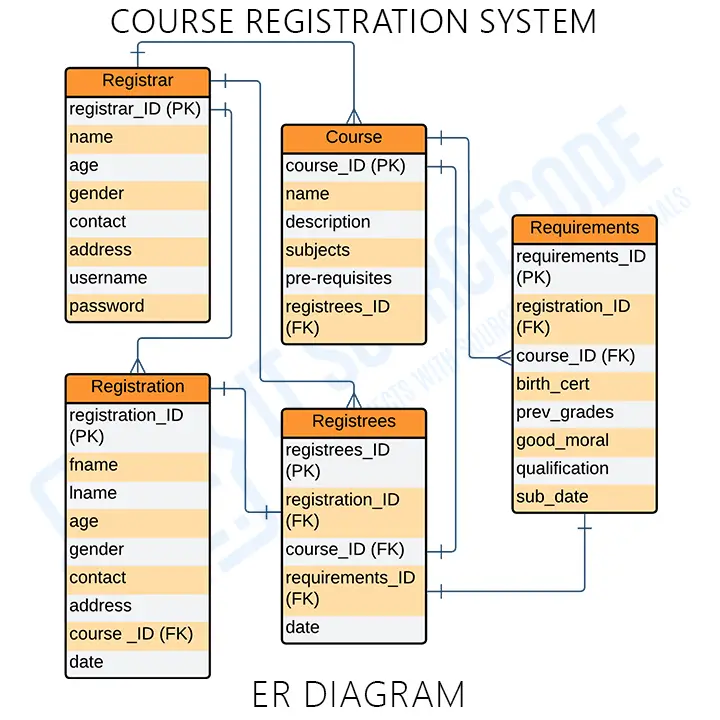This ER (Entity Relationship) Diagram shows how the Course Registration System ERD is set up. The entity-relationship diagram for the Course Registration System shows every visual representation of database tables as well as the connections between registrar, Course, registration, registries, requirements, and other variables.
Check out the articles below to find out more about ER diagrams and other things.
- Student Registration System ER Diagram
- ER Diagram for Student Enrollment System
- Component Diagram for Course Registration System
- Activity Diagram for Course Registration System
- ER Diagram for Student Management System
- Sequence Diagram for Course Registration System
ER diagram for course registration system: Details
The table shows the name and details of the ER diagram for course registration system. It has a complete description of the project’s information.
| Name: | Course Registration System ER Diagram |
| Abstract: | Using structure data, the links between the features of the Course Registration System’s structured data groups were set up. The main parts of the Course Registration System are the registrar, Course, registration, registries, requirements. |
| Diagram: | ER Diagram is also known as Entity Relationship Diagram |
| Tools Used: | Diagraming tools that provide ER diagram symbols. |
| Users: | School Registrar, Staff, and Students. |
| Designer: | ITSourceCode.com |
What is a Course Registration System?
A course registration system was created to allow students to be registered in the course of their choice. When compared to other forms that students have to fill out by hand, the registration form is easy to use and quick to fill out. This saves time and money.
Definition of ER Diagram
The Course Registration System ER Diagram is referred to as the software database design. This ER Diagram is the graphical depiction of relationships between all the entities involved in the system. Its major components are Entities, Attributes, and Relationships.
Importance of ER Diagram
The importance of ER diagram for course registration system is to help in modeling its data storage or database. It is the basis of the project’s database foundation for construction. This entity-relationship diagram (ERD) also aids in defining the data types to be stored such as their attributes and characteristics.
Course Registration System ER Diagram
ER Diagram of Course Registration System shows the system entity and the supposed functions in each relationship. It is the supposed database design of the project. This conveys the data that would be present in the registration system, its characteristics, and its connection with other data (entity).

This diagram presents the entities’ relational model for the course registration system. It is used to enlighten you on how the back end of the database of the project works. The tables are made to meet the required specification of the system and provide much more specific details of each entity within the system.
ER Diagram for Course Registration System with Tables
These tables below provide the complete database table details such as Field Name, Descriptions, data types, and character lengths.
Table Name: Registrar
| Field | Description | Type | Length |
| registrar_ID (PK) | Registrar ID | Int | 11 |
| name | Registrar Name | Varchar | 255 |
| age | Registrar Age | Int | 11 |
| gender | Registrar Gender | Varchar | 255 |
| contact | Registrar Contact | Int | 11 |
| address | Registrar Address | Text | |
| username | Registrar Username | Varchar | 255 |
| password | Registrar Password | Varchar | 255 |
Table Name: Course
| Field | Description | Type | Length |
| course_ID (PK) | Course ID | Int | 11 |
| name | Course Name | Varchar | 255 |
| description | Course Description | Text | |
| subjects | Course Subjects | Text | |
| pre-requisites | Course Pre-requisites | Text | |
| registrees_ID (FK) | Registrees ID | Int | 11 |
Table Name: Requirements
| Field | Description | Type | Length |
| requirements_ID (PK) | Requirements ID (PK) | Int | 11 |
| registration_Id (FK) | Registration ID (FK) | Int | 11 |
| course_ID (FK) | Course ID (FK) | Int | 11 |
| birth_cert | Birth Certificate | Varchar | 255 |
| prev_grades | Previous Grades | Varchar | 255 |
| good_moral | Good Moral | Varchar | 255 |
| qualification | Qualification | Varchar | 255 |
| sub_date | Submission Date | Date |
Table Name: Registration
| Field | Description | Type | 11 |
| registration_ID (PK) | Registration ID | Int | 11 |
| fname | First Name | Int | 11 |
| lname | Last Name | Int | 11 |
| age | Age | Int | 11 |
| gender | Gender | Varchar | 255 |
| contact | Contact | Int | 11 |
| address | Address | Text | |
| course_ID (FK) | Course ID | Int | 11 |
| date | Date | date |
Table Name: Registrees
| Field | Description | Type | Length |
| registrees_ID (PK) | Registrees ID | Int | 11 |
| registration_ID (FK) | Registration ID | Int | 11 |
| course_ID (FK) | Course ID | Int | 11 |
| requirements_ID (FK) | Requirements ID | Int | 11 |
| date | Date | date |
The tables given will be the basis for developers on how would they do the course registration system database design. It has the complete description of the database and they will put this into the program or data storage the same as the names given to each of the tables. They will create a database with the attributes given as well as the value of each attribute.
ER Diagram for Course Registration System [PDF]
The ER Diagram for Course Registration System PDF provides the information explaining the concepts of the project database. You may apply this information to your capstone project. You can also use it directly or modify its content depending on your project’s requirements.
How to Create Online Food Ordering System ER Diagram ER Diagram?
Time needed: 5 minutes
Here are the steps on how to create Online Food Ordering System ER Diagram
- Step 1: Become acquainted with the ER Diagram (Entity Relationship Diagram)
The Entity Relationship Diagram shows the structure of data types in a project. It uses symbols to clarify its parts and relationships. Their symbols and applications must be familiar before you build the ER Diagram.
ER Diagram Symbols:
Fields are the parts of a table that define the entity’s characteristics. In the database that the ERD models, attributes are commonly thought of as rows.
Keys are a technique to categorize data quality. It is used to organize ER diagrams and assist users in modeling their databases to ensure that they are efficient. This is also used to connect different tables in a database.
A primary key identifies a single entity instance, which means a unique attribute or set of attributes.
A foreign key is produced when data attributes have one too many relationships with other entities. - Step 2: Complete the entities that will be included.
Begin designing your ER Diagram by finalizing your railway reservation system’s entities. These are rectangles. You must leave room in future phases so they can be incorporated.
- Step 3: Add the attributes of each entity
Upon finalizing the entities, analyze their attributes. As characteristics, ER diagram entities are described. All these are characteristics. Multivalued characteristics have several values.
- Step 4: Describe the relationships (cardinality) between entities and attributes
Entities, characteristics, and relationships are needed to draw ERD relationships. The data structure and entity relationship diagram are based on evaluated information.
Conclusion
You need to know the diagrams used to design and develop the Course Registration System. That is to help you create a fully-functional system with the use of ER Diagram. Creating it will help you perceive the back end of the software. This will hold all the data that’ll enter and exit the system.
Inquiries
If you have inquiries or suggestions about Course Registration System ER Diagram, just leave us your comments below. We would be glad to know to concerns and suggestions and be part of your learning.
Keep us updated and Good day!

